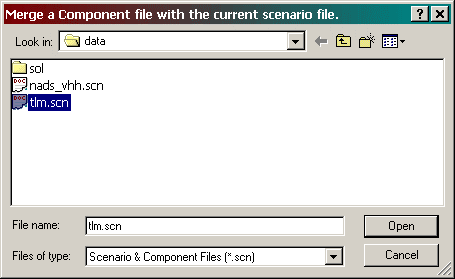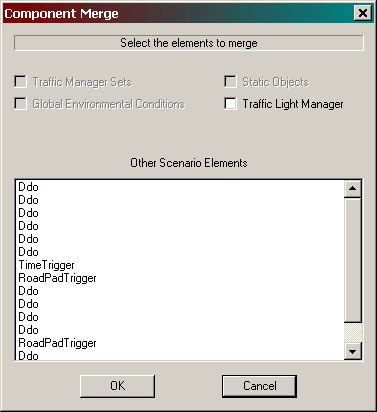Reusing Scenario Components
ISAT User's Guide Table of Contents
Introduction
Reuse is a desirable characteristic of any system that involves the development of detailed and laborious specifications. The ISAT allows the specification of numerous attributes associated with a virtual environment with the goal of providing deterministic and repeatable events to the simulator driver. Many of these specifications can take a lot of time to develop and tune, so it is desirable to have the ability to reuse them in other scenarios. The ISAT utilizes a component merge capability whose goal is to allow reuse of components that have been developed in other scenario files.
In general, when two scenarios use the same synthetic environment, any scenario elements can be used in either scenario. However, using scenario elements defined in the context of one synthetic environment in another scenario that uses a different synthetic environment is problematic. The key problem is the remapping of references to road network locations or objects that exist in one synthetic environment but may not exist in the other. Reusing a scenario event that utilizes a group of scenario elements in different parts of the same map poses similar problems. For example, a near-collision scenario caused by an ADO forced to run a red traffic light should be usable in any intersection, as long as it uses traffic lights. However, there are numerous issues involving the preservation of temporal relationships and event perception that cannot be easily addressed.
Because the solution of these problems is an active area of research, the ISAT utilizes two simpler methods to allow reuse. The first involves the use of Copy and Paste operations to reuse single scenario elements, and the second uses a Component Merge capability for reusing additional components.
Reuse through Copy and Paste
The Copy and Paste capability of the ISAT, combined with its multi-document interface design, can be used to copy elements from one scenario to the other. Specifically, the Paste operation allows the user to specify a new location on the road network of the new scenario that overrides the old location of the element. This allows reuse of scenario elements even across scenarios that use different synthetic environments.
This approach becomes problematic, however, in cases when many individual scenario elements have to be copied (as in the case of having manually placed numerous static objects all over the map), or for high-level coordinators such as the TM or TLM that cannot be copied to the clipboard. For such cases, use of the Component Merge capability can provide a solution.
Reuse through Component Merge
Component merge is a special operation activated by selecting Merge Components from the File menu. The dialog box shown in Figure 10-84 appears.
Select any scenario file that uses the same LRI (the virtual environment), whose components are to be reused. The dialog box shown in Figure 10-85 appears when Open is clicked.
Four separate components (TM, TLM, static objects, and global environment conditions) can be merged into the current scenario by selecting the appropriate check boxes. Note that only components that are actually defined in the selected scenario file are enabled. In the example shown in Figure 10-85, only the TLM is available for import.
When the TM box is selected, all TMIS are imported in the current scenario and added to any existing TMIS in the current scenario. Any TMIS in the current scenario with the same name as merged TMIS are over-written.
When the Static Objects check box is selected, all static objects defined in the new file are imported to the current scenario. Existing static objects are left untouched.
When the Global Environment Conditions check box is selected, the default (global) environment conditions in the new file are used in the current scenario, overwriting any pre-existing conditions in the current scenario.
Finally, when the Traffic Light Manager check box is selected, the traffic light settings for CLGs in the new file are brought into the current TLM set, overwriting any current settings.
In addition to global components, the Component Merge dialog box gives a list of individual traffic elements in the new file. Selecting any of them will copy them to the current file using their exact same placement and properties.


